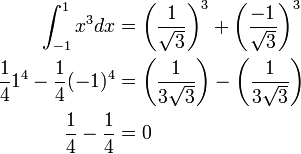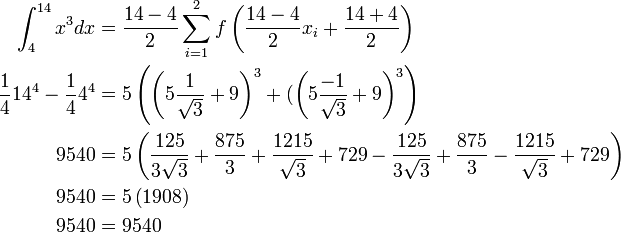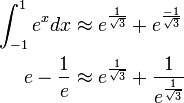Numerical Analysis/Gaussian Quadrature
< Numerical AnalysisFor the first example, I just want an example to show that the solution is exact for polynomials of degree  , using the
, using the  th degree Legendre polynomial. I'm going to approximate
th degree Legendre polynomial. I'm going to approximate  .
.

This problem accurately illustrates the method for solving problems using the Gaussian Quadrature algorithm. Note that the zeros of the Legendre polynomials of degree  are
are  and
and  .
.
We can see from the previous example that this method works quite well if we are integrating from  to
to  , but in application, we rarely want to integrate over such a simple region. So in our next example, we will show that this technique is also effective if we change the limits of integration, as seen on the Wikipedia page, then we will solve the example
, but in application, we rarely want to integrate over such a simple region. So in our next example, we will show that this technique is also effective if we change the limits of integration, as seen on the Wikipedia page, then we will solve the example 

We will next show how to solve a problem that isn't a simple polynomial. We will approximate  using a two point Gaussian approximation, and discuss the error analysis.
using a two point Gaussian approximation, and discuss the error analysis.

We will next analyze this error, looking at the actual error followed by finding the error bound. We denote the approximation by  and the exact solution by
and the exact solution by  .
.

The theoretical error bound when using the Legendre polynomial method is
![\begin{align}
\left|f_{exact}-f_{approx}\right| &\le \frac{(b-a)^{2n+1}(n!)^4}{(2n+1)\left[(2n)!\right]^3} f^{(2n)}\left(\xi\right), a<\xi<b \\
&\le \frac{2^5 2^4}{5*4!^3} e \\
&= \frac{2^9}{5*24^3} e \\
&= 0.02013542095154848322489
\end{align}](../I/m/bc8efd952c7befdfa9f0be4ab9aa3a8b.png)
In our example, the actual error was well within the error bound. We also see that with only two calculations, this is a very good algorithm for approximating integrals quickly with relatively good accuracy.
Exercises
1. Show that Gaussian Quadrature can solve exactly general cubic polynomials.
a) Set up the integral:
Solution:

b) Evaluate the integral:
Solution:

c) Evaluate the approximation:
Solution:

d) Do parts b and c correspond?
Solution:
Yes
2. Approximate  using Gaussian Quadrature
using Gaussian Quadrature
a) Evaluate the problem symbolically:
Solution:

b) Evaluate the approximation:
Solution:

c) Find the actual error
Solution:

d) Find the error bound
Solution:
![\begin{align}
\left|f_{exact}-f_{approx}\right| &\le \frac{(b-a)^{2n+1}(n!)^4}{(2n+1)\left[(2n)!\right]^3} f^{(2n)}\left(\xi\right), a<\xi<b \\
&\le \frac{2^5 2^4}{5*4!^3} f^4(\xi) \\
&\le \frac{2^9}{5*24^3} * 20.1824 \\
&\le 0.14949925
\end{align}](../I/m/500f2274bc63cc280bdf3c5ba0592cf3.png)
d) Is the actual error less than the error bound?
Solution:
Yes
3. If  are the roots of the
are the roots of the  th Legendre Polynomial
th Legendre Polynomial  and that for each
and that for each  , the numbers
, the numbers  are defined by
are defined by

Prove that if  is any polynomial of degree less than
is any polynomial of degree less than  , then
, then

Proof:
The set that is relevant to this proof is the set of Legendre Polynomials, a collection orthogonal polynomials  with properties:
with properties:
- For each
 is a monic polynomial of degree
is a monic polynomial of degree  .
. -
 whenever
whenever  is a polynomial of degree less that
is a polynomial of degree less that  .
.
First we use polynomial division, to get  with a remainder term
with a remainder term  , so that
, so that  and the two polynomials
and the two polynomials  and
and  are of degree less than
are of degree less than  and
and  is of degree
is of degree  . Then using this fact we can rewrite the original integral into the form
. Then using this fact we can rewrite the original integral into the form
 .
.
Since the degree of  is less than twice the degree of the w: Legendre polynomial, then the degree of
is less than twice the degree of the w: Legendre polynomial, then the degree of  is less than the degree of
is less than the degree of  . So (by Legendre property 2 started above),
. So (by Legendre property 2 started above),  . Thus we see that
. Thus we see that  . We do not know what
. We do not know what  is, but we know it has degree less than
is, but we know it has degree less than  so it equals the polynomial that interpolates it at the values
so it equals the polynomial that interpolates it at the values  . We will use the w: Lagrange polynomial form. Since
. We will use the w: Lagrange polynomial form. Since  is a roots of
is a roots of  for each
for each  , we have
, we have
Since  is a polynomial of degree less than
is a polynomial of degree less than  , then Lagrange polynomial for
, then Lagrange polynomial for  is
is
 .
.
We next integrate this polynomial by
 .
.
Since  is a constant, we will pull that outside the integral, giving us
is a constant, we will pull that outside the integral, giving us
 .
.
We then note that
 ,
,
so we will substitute  into our integration, giving us
into our integration, giving us
This completes the proof.
Gaussian Quadrature Example
I realized that there was insufficient information after the derived and solved sample on Gaussian Quadrature thus i took the pain to edit this wikiversity page by adding a solved example to the information already on there and below is what i factored in.
Find the constants C_0, C_1, and x_1 so that the quadrature formula
has the highest possible degree of precision.
Solution
Since there are three unknowns, C_0, C_1 and x_1, we will expect the formula to be exact for
Thus
Equation 2 and 3 will yield.
Hence
Now,
And
Thus the degree of the precision is 2







